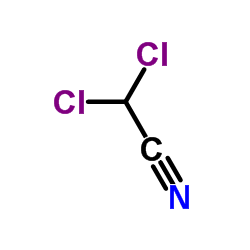二氯乙腈
一般危化品

二氯乙腈结构式
|
常用名 | 二氯乙腈 | 英文名 | Dichloroacetonitrile |
|---|---|---|---|---|
| CAS号 | 3018-12-0 | 分子量 | 109.942 | |
| 密度 | 1.4±0.1 g/cm3 | 沸点 | 112.5±0.0 °C at 760 mmHg | |
| 分子式 | C2HCl2N | 熔点 | N/A | |
| MSDS | 中文版 美版 | 闪点 | 35.6±0.0 °C | |
| 符号 |



GHS02, GHS05, GHS07 |
信号词 | Danger |
|
The formation potential of haloacetonitriles in the Dez River water, Iran.
Environ. Technol. 35(17-20) , 2347-55, (2014) The formation potential of haloacetonitriles (HANsFP) from chlorination of raw water of the Dez River in Iran was determined. Samples were collected before treatment at an intake of a water treatment plant. Tests were carried out to determine the effect of th... |
|
|
Genotoxic activity of five haloacetonitriles: comparative investigations in the single cell gel electrophoresis (comet) assay and the ames-fluctuation test.
Environ. Mol. Mutagen. 36(1) , 52-8, (2000) Halogenated acetonitriles (HANs) are known to be water disinfectant by-products. Their mutagenicity and carcinogenicity have been shown in different test systems in vivo and in vitro. They also have clastogenic properties. In this study, the ability of HAN to... |
|
|
Exposure to mutagenic disinfection byproducts leads to increase of antibiotic resistance in Pseudomonas aeruginosa.
Environ. Sci. Technol. 48(14) , 8188-95, (2014) Bacterial antibiotic resistance (BAR) in drinking water has become a global issue because of its risks on the public health. Usually, the antibiotic concentrations in drinking water are too low to select antibiotic resistant strains effectively, suggesting th... |
|
|
Volatile disinfection by-product analysis from chlorinated indoor swimming pools.
Water Res. 43(13) , 3308-18, (2009) Chlorination of indoor swimming pools is practiced for disinfection and oxidation of reduced compounds that are introduced to water by swimmers. However, there is growing concern associated with formation for chlorinated disinfection by-products (DBPs) in the... |
|
|
Dichloroacetonitrile, a by-product of water chlorination, induces aneuploidy in Drosophila.
Mutat. Res. 261(2) , 85-91, (1991) Nitriles have been shown to be potent inducers of aneuploidy in yeast and Drosophila test systems. Haloacetonitriles are by-products of water chlorination that have been shown to be mutagenic and carcinogenic following topical application. In this report we s... |
|
|
Excretion and tissue disposition of dichloroacetonitrile in rats and mice.
Environ. Health Perspect. 69 , 215-20, (1986) The excretion and tissue distribution of [1-14C]dichloroacetonitrile and [2-14C]dichloroacetonitrile were studied in male Fischer 344 rats and male B6C3F1 mice. Three dose levels of dichloroacetonitrile (DCAN) (0.2, 2, or 15 mg/kg) were administered to rats a... |
|
|
Nitrogen enriched dissolved organic matter (DOM) isolates and their affinity to form emerging disinfection by-products.
Water Sci. Technol. 60(1) , 135-43, (2009) Increased contributions from wastewater discharges and algal activity in drinking water supplies can lead to elevated levels of dissolved organic nitrogen (DON), which can increase the likelihood for the formation of emerging nitrogenous disinfection by-produ... |
|
|
Formation of nitrogenous disinfection by-products from pre-chloramination.
Chemosphere 85(7) , 1187-91, (2011) A sampling survey investigated the formation of nitrogenous disinfection by-products (N-DBPs) and carbonaceous DBPs (C-DBPs) from pre-chloramination, an increasingly common treatment strategy in China for regulated C-DBP control, followed by subsequent conven... |
|
|
Influence of the method of reagent addition on dichloroacetonitrile formation during chloramination.
Environ. Sci. Technol. 44(2) , 700-6, (2010) Formation of dichloroacetonitrile (DCAN) in natural waters was evaluated for different disinfection scenarios, including application of free chlorine, preformed monochloramine or dichloramine, or formation of chloramines in situ by addition of free chlorine a... |
|
|
Possible role of hydroxyl radicals in the oxidation of dichloroacetonitrile by Fenton-like reaction.
J. Inorg. Biochem. 84(1-2) , 97-105, (2001) Dichloroacetonitrile (DCAN), is a member of haloacetonitrile group and detected in drinking water supplies as a by-product of chlorination process. The mechanism of DCAN-induced carcinogenesis is believed to be mediated by oxidative bioactivation of DCAN mole... |